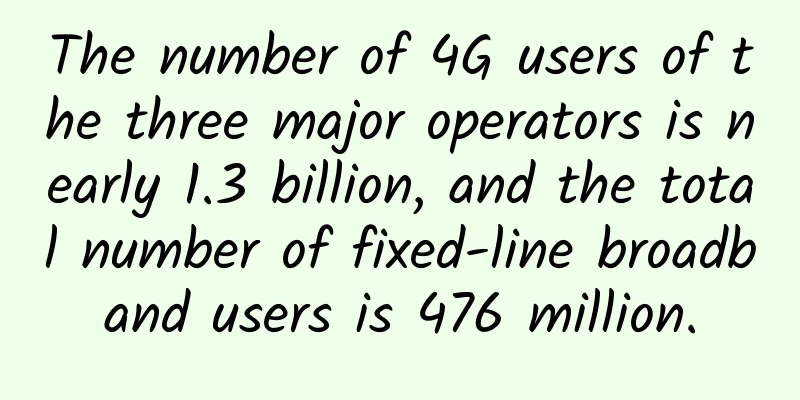The number of 4G users of the three major operators is nearly 1.3 billion, and the total number of fixed-line broadband users is 476 million.

|
Data released by the Ministry of Industry and Information Technology showed that as of the end of September, the total number of mobile phone users of the three basic telecommunications companies reached 1.6 billion, a year-on-year increase of 0.1%. Among them, the number of 4G users was 1.293 billion, a year-on-year increase of 2.3%, accounting for 80.8% of the total number of mobile phone users, an increase of 0.7 percentage points from the end of last year. Proportion of total 4G users at the end of September 2019-2020 As of the end of September, the total number of fixed Internet broadband access users of the three basic telecommunications companies reached 476 million, a year-on-year increase of 5.8%, a net increase of 26.82 million households compared with the end of last year. Among them, there were 445 million fiber-optic access (FTTH/O) users, accounting for 93.5% of the total number of fixed Internet broadband access users. The number of fixed Internet broadband access users with access speeds of 100Mbps and above reached 420 million, accounting for 88.2% of the total number of users, an increase of 2.8 percentage points from the end of last year; the promotion of gigabit broadband services accelerated, and the number of fixed Internet broadband access users with access speeds of 1000Mbps and above reached 4.25 million, a net increase of 3.38 million households compared with the end of last year (870,000 households). Percentage of users with fiber-optic access (FTTH/O) and fixed Internet broadband access with access speeds of 100 Mbps and above from 2019 to the end of September 2020 Data shows that as of the end of September, the three basic telecommunications companies had developed 1.336 billion mobile Internet users, with a penetration rate of 83.5% for mobile phone users, an increase of 1.3 percentage points from the end of last year. There were 1.073 billion cellular Internet of Things terminal users, a year-on-year increase of 18.2%, a net increase of 44.92 million from the end of last year, of which terminal users used in smart manufacturing, smart transportation, and smart public utilities accounted for 19.6%, 19%, and 22.7% respectively. The total number of IPTV (Internet TV) users reached 310 million, a year-on-year increase of 6%, a net increase of 15.8 million from the end of last year. Mobile Internet users at the end of September 2019-2020 |
<<: Single Sign On (Single Sign On) is enough to read this article
>>: Gartner lamented that there has never been such a volatile market in 25 years
Recommend
Animation: How does a browser work?
For most of the front-end developers interviewed,...
Summary of common troubleshooting methods for network broadband
1. FTTH troubleshooting steps Step 1: Check the s...
If I have an unlimited data plan, should I cancel my home wired broadband?
In fact, if it is a truly unlimited data package,...
RepriseHosting: Seattle Server $27.97/month - L5640, 16G RAM, 1TB HDD/240G SSD, 1Gbps Bandwidth
RepriseHosting (AS62838) is still promoting its d...
In 2025, the 5G core market size will reach US$9.497 billion
According to ResearchAndMarkets, the global 5G co...
Explain the five major network concepts in a vivid and interesting way
The update of 5G technology has promoted the deve...
my country has entered the ranks of innovative countries, with remarkable achievements in 5G, artificial intelligence, and autonomous driving
The world trend is surging forward. If we stop th...
China Mobile: 5G package customers reach 331 million
China Mobile released its unaudited financial dat...
The pain of transformation in the gaming industry is evident as Digital Sky successfully breaks through with the help of Huawei Cloud
[51CTO.com original article] In 2017, the total r...
The Ministry of Industry and Information Technology has indicated 10 important directions for 5G development in 2020!
On January 20, the State Council Information Offi...
CAN bus: operating principle, advantages and disadvantages
The CAN bus was originally designed by Bosch in t...
How is LOCVPS? Simple test of LOCVPS Hong Kong Tai Po VPS
Last month, we conducted a simple test on LOCVPS ...
Who made a comeback! Operators' February data: China Unicom's 5G business ushered in a highlight moment
[[389252]] Yesterday, the three major operators a...
RAKsmart adds new user discount code + recharge gift, Hong Kong/Japan/Singapore/Korea/US servers starting from $30/month
In addition to the recharge gift event, RAKsmart ...
Learn dynamic routing protocols from scratch and never get lost in network routing again!
Classification of dynamic routing protocols Class...









